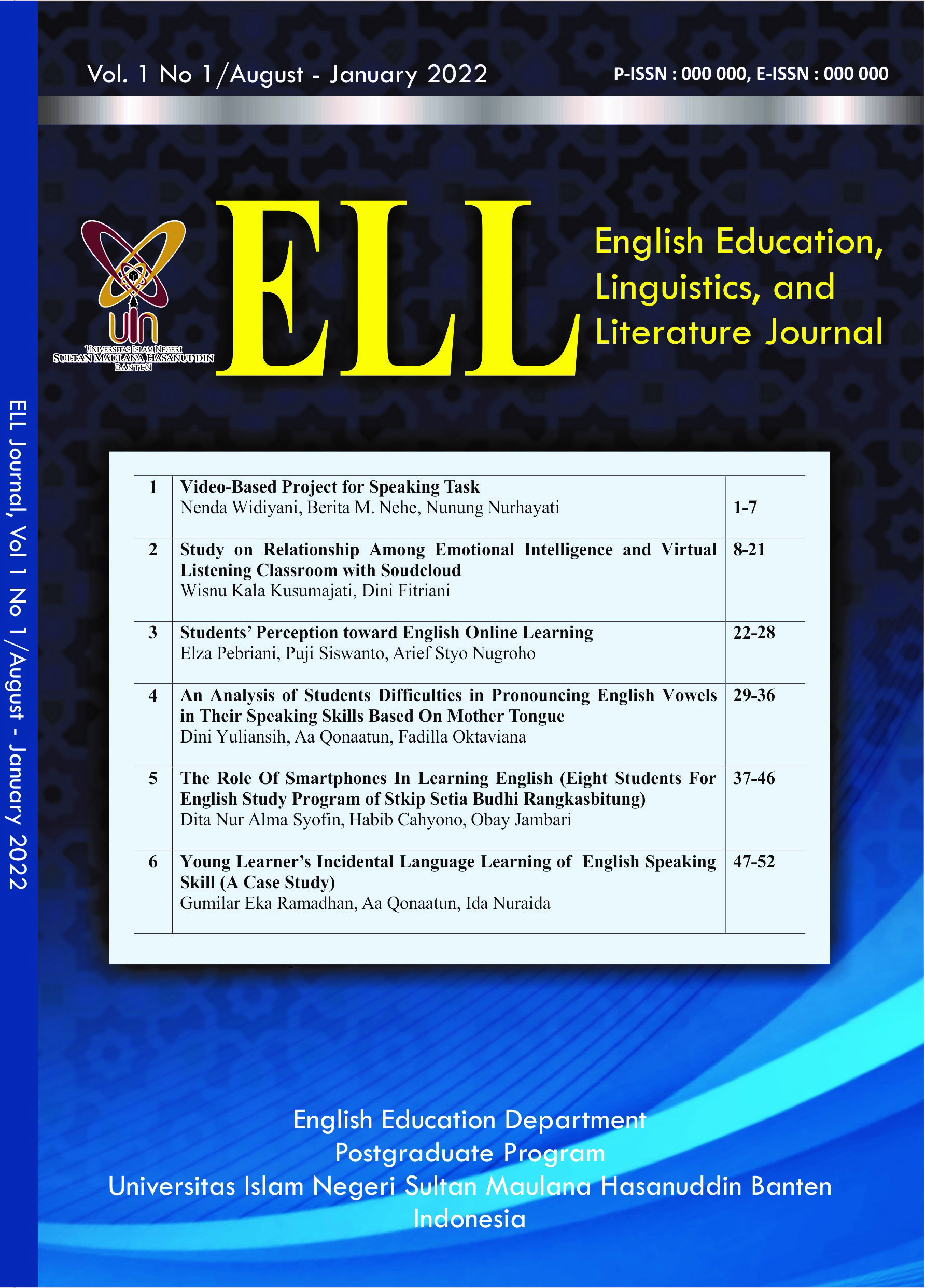Video-Based Project for Speaking Task
DOI:
https://doi.org/10.32678/ell.v1i1.5656Abstract
Abstract: This research was conducted to increase the speaking ability of eighth grade students of MTs. Darul Huda Cileles. Video-based project teaching is proposed in teaching speaking because it is interesting, especially for descriptive texts. Several previous studies found that video media can encourage kids to become more active and engaged willing to speak, so that their speaking skills can be improved. This study uses a classroom action research design. Researchers and teachers work together in designing lesson plans, criteria of success, action stages, observation stages, and reflections. The participants in this research were students in class VIII MTs Darul Huda Cileles for the academic year 2021/2022. This research was conducted by following action research procedures, namely planning, acting, observing, and reflecting. The percentage of students who achieved a score above the predetermined minimum completeness score (KKM) increased from only 20% (3 students out of 15 students) in the preliminary study to 50% (6 students out of 15 students). Students experienced a significant increase in scores obtained from video 1 and video 2. The first criterion was 11 students out of 15 students or 74% of students passed the KKM. For the second criterion, 74% of students are able to speak 8 sentences. For the third criterion, 74% of students are able to produce 8 sentences orally. After passing the research target where the criteria of success were 65% of students passed the KKM, and students passed the predetermined success criteria of 74%. For future researchers, it is recommended to conduct more than one preliminary study in order to identify the problem more accurately.
Downloads
References
David Brecht, H. (2012). Learning from Online Video Lectures. Journal of Information Technology Education: Innovations in Practice, 11, 227–250. https://doi.org/10.28945/1712
Fitria. (2013). EMERGING TECHNOLOGIES AND VIDEO MEDIATED INSTRUCTIONAL STRATEGIES IN CONTEMPORARY EDUCATIONAL SYSTEM IN NIGERIA. Journal of Chemical Information and Modeling, 53(9), 1689–1699.
Galymov, V. (2010). This reproduction is the best copy available. ® UMI. In Education.
Illeris, K. (2014). Transformative Learning re-defined: as changes in elements of the identity. International Journal of Lifelong Education, 33(5), 573–586. https://doi.org/10.1080/02601370.2014.917128
Kemmis, S. (2010). What is to be done? the place of action research. Educational Action Research, 18(4), 417–427. https://doi.org/10.1080/09650792.2010.524745
Lee, J. S. (2020). The role of grit and classroom enjoyment in EFL learners’ willingness to communicate. Journal of Multilingual and Multicultural Development, 0(0), 1–17. https://doi.org/10.1080/01434632.2020.1746319
Marzuqi, A. M. I., & Firdaus, D. (2019). the Use of Demonstration Technique in Improving Learners’ Speaking Ability. PROJECT (Professional Journal of English Education), 2(6), 896. https://doi.org/10.22460/project.v2i6.p896-903
Mulyono, H., & Saskia, R. (2021). Affective variables contributing to Indonesian EFL students’ willingness to communicate within face-to-face and digital environments. Cogent Education, 8(1). https://doi.org/10.1080/2331186X.2021.1911282
Mulyono, H., Saskia, R., Arrummaiza, V. S., & Suryoputro, G. (2020). Psychometric assessment of an instrument evaluating the effects of affective variables on students’ WTC in face-to-face and digital environment. Cogent Psychology, 7(1). https://doi.org/10.1080/23311908.2020.1823617 No, J. D., & Tengah, J. (2020). 5(52), 147–158.
Olanrewaju, O. (2017). Effect of Using Video Mediated Instruction as an Advanced Organizer on the Effect of Using Video Mediated Instruction as an Advanced Organizer on the Cognitive Achievement of Students in Mathematics. 6(March), 123–131.
Osterman, G. L. (2014). Experiences of Japanese University students’ willingness to speak english in class: A multiple case study. SAGE Open, 4(3). https://doi.org/10.1177/2158244014543779
Riasati, M. J., & Noordin, N. (2011). Antecedents of willingness to communicate: A review of literature. Studies in Literature and Language, 3(2), 74–80. https://doi.org/10.3968/j.sll.1923156320110302.326
Riasati, Mohammad Javad. (2012). EFL learners’ perception of factors influencing willingness to speak English in language classrooms: A qualitative study. World Applied Sciences Journal, 17(10), 1287–1297.
Shen, X., & Byfield, L. (2018). Promoting English Learners’ Willingness to Communicate in Content-area Classrooms. The Clearing House: A Journal of Educational Strategies, Issues and Ideas, 91(6), 250–257. https://doi.org/10.1080/00098655.2018.1541856
Silitonga, F., & Astuti, L. P. (2018). From Teaching of Sundanese’s Teenager Speaking Ability In Batam: Spoken Discourse Analysis. International Journal of Language Teaching and Education, 2(3), 325–333. https://doi.org/10.22437/ijolte.v2i3.5182
Tarp, G. (2020). Intercultural encounters and their influence on willingness to communicate in a second language other than English. Language and Intercultural Communication, 20(3), 270–283. https://doi.org/10.1080/14708477.2020.1741602
Downloads
Published
Issue
Section
License
Copyright (c) 2022 Nenda Widiyani, Berita M Nehe, Nunng Nurhayati

This work is licensed under a Creative Commons Attribution-ShareAlike 4.0 International License.






